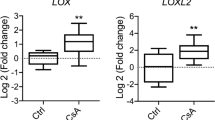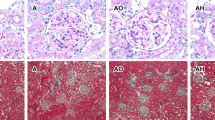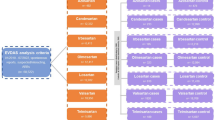Abstract
Background:
Chronic cyclosporine A (CsA) nephrotoxicity is manifested by renal dysfunction, progressive histopathological kidney lesions characterized by afferent arteriolopathy, and tubulointerstitial fibrosis. In addition to the direct toxic effect of CsA, many other etiological factors such as angiotensin II, transforming growth factor (TGF)-β, and macrophage infiltration are involved in this pathogenesis. This study investigated the hypothesis that concomitant administration of mizoribine (MZR) and angiotensin II receptor blockade (ARB) may prevent CsA nephrotoxicity in rats.
Methods:
Sprague-Dawley male rats were divided into the following seven groups: group 1, treated with CsA; group 2, treated with CsA + MZR; group 3, treated with CsA + valsartan (Val); group 4, treated with CsA + MZR + Val; group 5, treated with MZR; group 6, treated with Val; and group 7, controls (n = 5 each). Renal histopathology and the effect of CsA-induced nephrotoxicity on inflammatory mediators were evaluated.
Results:
Results of this study demonstrated that ARB administration significantly decreased arteriolopathy and that in comparison with monotherapy, concomitant administration of MZR and ARB further decreased arteriolopathy, fibrosis, macrophage infiltration, and TGF-β1 mRNA expression associated with CsA nephrotoxicity.
Conclusion:
These findings indicate that MZR and ARB combination treatment provides synergistic protective effects against chronic CsA nephrotoxicity.
Similar content being viewed by others
Log in or create a free account to read this content
Gain free access to this article, as well as selected content from this journal and more on nature.com
or
References
Fujinaga S, Kaneko K, Muto T, Ohtomo Y, Murakami H, Yamashiro Y . Independent risk factors for chronic cyclosporine induced nephropathy in children with nephrotic syndrome. Arch Dis Child 2006;91:666–70.
Thomas SE, Andoh TF, Pichler RH, et al. Accelerated apoptosis characterizes cyclosporine-associated interstitial fibrosis. Kidney Int 1998;53:897–908.
Mizuno K, Tsujino M, Takada M, Hayashi M, Atsumi K . Studies on bredinin. I. Isolation, characterization and biological properties. J Antibiot 1974;27:775–82.
Sakai T, Kawamura T, Shirasawa T . Mizoribine improves renal tubulointerstitial fibrosis in unilateral ureteral obstruction (UUO)-treated rat by inhibiting the infiltration of macrophages and the expression of alpha-smooth muscle actin. J Urol 1997;158:2316–22.
Yamabe H, Shimada M, Murakami R, Fujita T, Shimaya Y, Nakamura N . Mizoribine suppresses proliferation of rat glomerular epithelial cells in culture and inhibits increase of monocyte chemoattractant protein-1 and macrophage inflammatory protein-2 stimulated by thrombin. Biol Pharm Bull 2012;35:705–8.
Hara S, Umino D, Someya T, et al. Protective effects of mizoribine on cyclosporine A nephropathy in rats. Pediatr Res 2009;66:524–7.
Yang CW, Ahn HJ, Kim WY, et al. Influence of the renin-angiotensin system on epidermal growth factor expression in normal and cyclosporine-treated rat kidney. Kidney Int 2001;60:847–57.
Lassila M . Interaction of cyclosporine A and the renin-angiotensin system; new perspectives. Curr Drug Metab 2002;3:61–71.
Lin J, Valeri AM, Markowitz GS, D’Agati VD, Cohen DJ, Radhakrishnan J . Angiotensin converting enzyme inhibition in chronic allograft nephropathy. Transplantation 2002;73:783–8.
Yang CW, Ahn HJ, Kim WY, et al. Synergistic effects of mycophenolate mofetil and losartan in a model of chronic cyclosporine nephropathy. Transplantation 2003;75:309–15.
Müller-Schweinitzer E . Changes in the venous compliance by bradykinin and angiotensin II and its significance for the vascular effects of cyclosporine-A. Naunyn Schmiedebergs Arch Pharmacol 1988;338:699–703.
Julien J, Farge D, Kreft-Jais C, et al. Cyclosporine-induced stimulation of the renin-angiotensin system after liver and heart transplantation. Transplantation 1993;56:885–91.
Takeda Y, Itoh Y, Yoneda T, Miyamori I, Takeda R . Cyclosporine A induces endothelin-1 release from cultured rat vascular smooth muscle cells. Eur J Pharmacol 1993;233:299–301.
Myers BD, Ross J, Newton L, Luetscher J, Perlroth M . Cyclosporine-associated chronic nephropathy. N Engl J Med 1984;311:699–705.
Mihatsch MJ, Kyo M, Morozumi K, Yamaguchi Y, Nickeleit V, Ryffel B . The side-effects of ciclosporine-A and tacrolimus. Clin Nephrol 1998;49:356–63.
Morozumi K, Takeda A, Uchida K, Mihatsch MJ . Cyclosporine nephrotoxicity: how does it affect renal allograft function and transplant morphology? Transplant Proc 2004;36(2 Suppl):251S–6S.
Zhong Z, Arteel GE, Connor HD, et al. Cyclosporin A increases hypoxia and free radical production in rat kidneys: prevention by dietary glycine. Am J Physiol 1998;275(4 Pt 2):F595–604.
Djamali A . Oxidative stress as a common pathway to chronic tubulointerstitial injury in kidney allografts. Am J Physiol Renal Physiol 2007;293:F445–55.
Pichler RH, Franceschini N, Young BA, et al. Pathogenesis of cyclosporine nephropathy: roles of angiotensin II and osteopontin. J Am Soc Nephrol 1995;6:1186–96.
Shihab FS, Andoh TF, Tanner AM, et al. Role of transforming growth factor-beta 1 in experimental chronic cyclosporine nephropathy. Kidney Int 1996;49:1141–51.
Islam M, Burke JF Jr, McGowan TA, et al. Effect of anti-transforming growth factor-beta antibodies in cyclosporine-induced renal dysfunction. Kidney Int 2001;59:498–506.
Young BA, Burdmann EA, Johnson RJ, et al. Cellular proliferation and macrophage influx precede interstitial fibrosis in cyclosporine nephrotoxicity. Kidney Int 1995;48:439–48.
Pankiewicz KW, Patterson SE, Black PL, et al. Cofactor mimics as selective inhibitors of NAD-dependent inosine monophosphate dehydrogenase (IMPDH)–the major therapeutic target. Curr Med Chem 2004;11:887–900.
Tanaka H, Oki E, Tsuruga K, et al. Mizoribine treatment of young patients with severe lupus nephritis: a clinicopathologic study by the tohoku pediatric study group. Nephron Clin Pract 2008;110:c73–9.
Kawasaki Y, Hosoya M, Suzuki J, et al. Efficacy of multidrug therapy combined with mizoribine in children with diffuse IgA nephropathy in comparison with multidrug therapy without mizoribine and with methylprednisolone pulse therapy. Am J Nephrol 2004;24:576–81.
Yoshioka K, Ohashi Y, Sakai T, et al. A multicenter trial of mizoribine compared with placebo in children with frequently relapsing nephrotic syndrome. Kidney Int 2000;58:317–24.
Sato N, Shiraiwa K, Kai K, et al. Mizoribine ameliorates the tubulointerstitial fibrosis of obstructive nephropathy. Nephron 2001;89:177–85.
Matsui K, Ueda H, Terada M, Azuma N, Okamura H, Sano H . Mizoribine protects against bleomycin-induced lung injury. Mod Rheumatol 2010;20:471–7.
Shihab FS, Bennett WM, Tanner AM, Andoh TF . Angiotensin II blockade decreases TGF-beta1 and matrix proteins in cyclosporine nephropathy. Kidney Int 1997;52:660–73.
Yoon HE, Ghee JY, Piao S, et al. Angiotensin II blockade upregulates the expression of Klotho, the anti-ageing gene, in an experimental model of chronic cyclosporine nephropathy. Nephrol Dial Transplant 2011;26:800–13.
Acknowledgements
The authors are grateful to Yumiko Sakurai and Takako Ikegami of the Division of Molecular and the Biochemical Research, Biomedical Research Center, Juntendo University Graduate School of Medicine, for their extended technical support.
Author information
Authors and Affiliations
Corresponding author
Rights and permissions
About this article
Cite this article
Endo, A., Someya, T., Nakagawa, M. et al. Synergistic protective effects of mizoribine and angiotensin II receptor blockade on cyclosporine A nephropathy in rats. Pediatr Res 75, 38–44 (2014). https://doi.org/10.1038/pr.2013.169
Received:
Accepted:
Published:
Issue date:
DOI: https://doi.org/10.1038/pr.2013.169
This article is cited by
-
The inflammatory state provokes sexual dimorphism in left ventricular and electrocardiographic effects of chronic cyclosporine in rats
Scientific Reports (2017)
-
Influence of cyclosporine A on glomerular growth and the effect of mizoribine and losartan on cyclosporine nephrotoxicity in young rats
Scientific Reports (2016)



